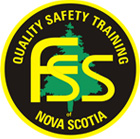Compressed Air
Hazards Identified
Dust and flying debris, injection (skin penetration, noise
Hazard-Specific Personal Protective
Safety glasses, goggles or face shield, hearing protection, gloves and coveralls
Hazard-Specific Training
Training by a competent person
Safe Work Practice
- A First Aid Kit and Eye Wash Station must be on site.
- Make sure that other workers in the area are aware of the hazard or have restricted access to the area.
- To avoid injection hazard, do not use compressed air to clean clothes.
- Use the correct air supply hoses for the tool or equipment being used.
- All hose connections for shop tools (up to ½ inch lines) must be of the quick disconnect type.
- All hose connections must be secured to the hose with proper crimping clips. Do not use hose clamps.
- Check hoses for cuts, bulges or other damage. Replace or repair damaged or defective hoses.
- Do not exceed rated pressure for any component in the system.
- Turn off and lock out compressor and relieve pressure in line before repairing or maintaining the system.
- Operate and maintain compressor and tools according to manufacturer’s instructions.
For a mobile compressor:
- Chock wheels to ensure stability before turning on the compressor.
- For hoses larger than 1.2 inch, ensure that connections are secure and wired together before use.
- Before refuelling, turn off the compressor and allow the engine to cool. Refuel outdoors or in a well-ventilated area. Store and transport fuel in a proper container.
Regulations, Standards and References
Occupational Safety General Regulations
